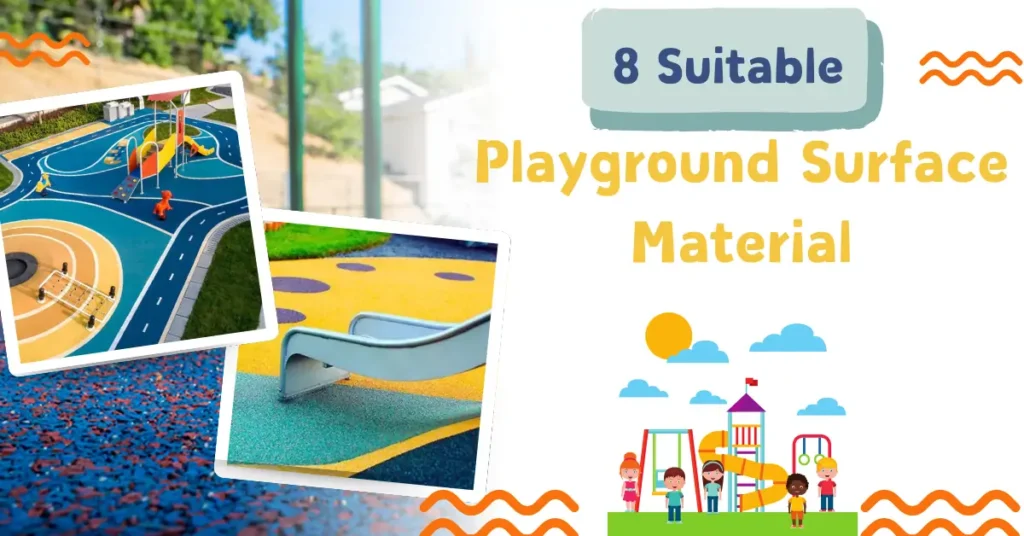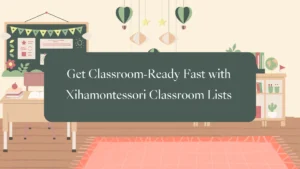Are you building or renovating a playground and looking for the perfect surface material? Providing children with a safe and appropriate play space is more important than ever. Every parent and caregiver wants the best for their children, and choosing the right playground surface materials is critical to creating a safe environment. With so many available options, it can be challenging to determine which material is best for your needs.
Having safe and durable playground surface material is essential for any playground. Not only does it provide a cushioning effect to minimize the risk of injury, but it also ensures longevity and easy maintenance.
We’ll discuss the pros and cons of each material, and you’ll get a clear picture of which playground surface material is best for your specific needs. Whether you’re a school administrator looking to update your playground or a homeowner considering a backyard play area, our guide will help you choose the perfect playground surface material for your requirements.
Importance of Choosing the Right Playground Surface Material
Regarding playground safety, it is important to consider playground surface materials. The right playground surface material should provide cushioning to reduce the risk of fall injuries and be non-toxic and durable. Each material has unique properties and benefits, so it’s important to understand the options available before deciding.
The surface material’s Critical Fall Height (CFH) is crucial. The CFH refers to the maximum height from which a child can fall without sustaining a severe injury. Different materials have varying CFH ratings, so choosing a material that matches the height of your play equipment is essential.
Another consideration is the maintenance required for each surface material. Some materials require regular upkeep, such as raking or replenishing, while others require less maintenance. Understanding the maintenance needs of each material will help you make an informed decision based on your available resources.
The playground’s aesthetic appeal and overall design should also be considered. Some materials may complement specific themes or provide a more visually appealing playground environment. Considering the overall look and feel you want to achieve can help guide your decision-making process.
1. Rubber Mulch Playground Surface Material
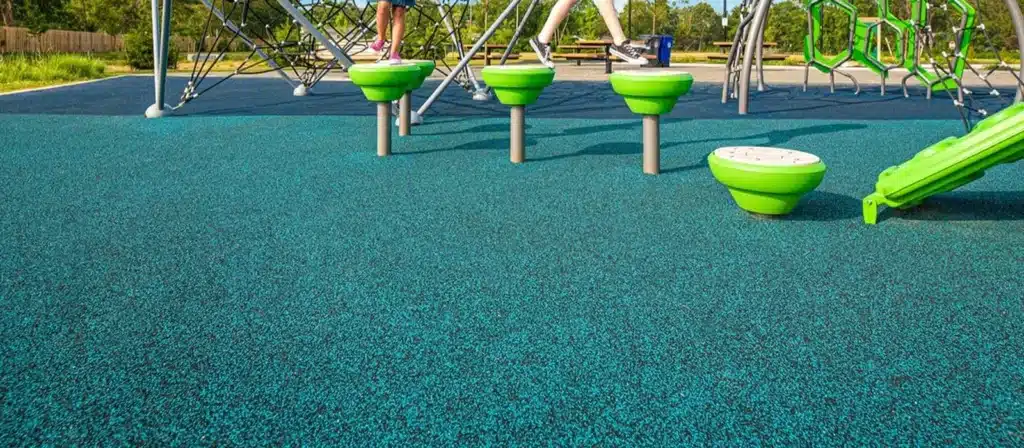
Rubber mulch is a popular, versatile playground surface material with excellent shock absorption and durability. Made from recycled rubber, it provides an eco-friendly option for playgrounds. Rubber mulch is available in various colors and textures, allowing you to create a visually appealing play area.
One of the significant advantages of rubber mulch is its ability to cushion falls, reducing the risk of injuries. Its high CFH rating makes it suitable for play equipment of different heights. Additionally, rubber mulch is non-toxic, making it safe for children to play on.
Rubber mulch can retain heat, making it hot on sunny days. It also requires occasional raking to maintain an even surface. Despite these minor drawbacks, rubber mulch remains a popular playground choice due to its excellent safety features and durability.
2. Engineered Wood Fiber Playground Surface Material
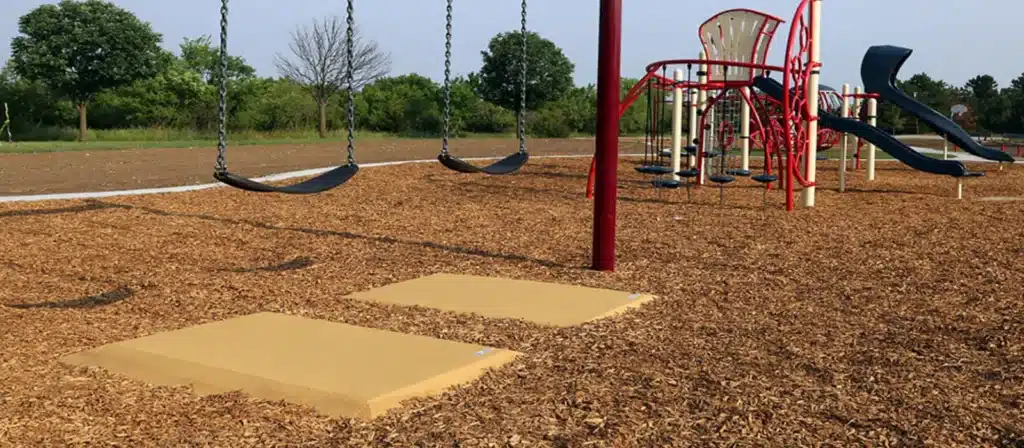
Engineered wood fiber, or EWF, is another popular playground surface material. It is made from shredded wood and offers natural aesthetics while providing excellent shock absorption. EWF is an affordable option that meets safety standards and is widely used in public and private playgrounds.
The loose-fill nature of EWF allows it to cushion falls effectively, reducing the risk of serious injuries. It also drains well, minimizing the accumulation of water and preventing puddles from forming. EWF requires regular maintenance, including raking and replenishing, to maintain its desired depth and evenness.
One consideration when using EWF is its potential for splinters. While efforts are made to minimize the risk, small splinters can still occur over time. Regular inspections and proper maintenance can help mitigate this issue. EWF provides a natural, cost-effective playground surface material that promotes safety and a visually pleasing environment.
3. Artificial Turf Playground Surface Material
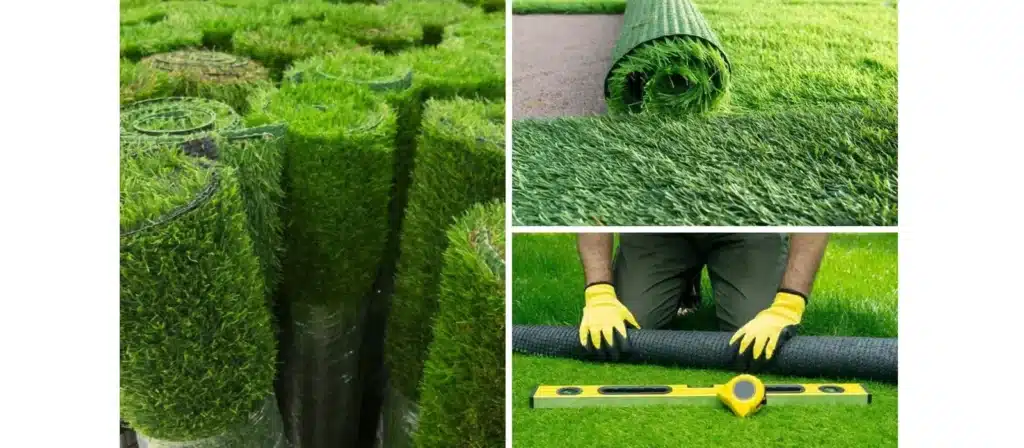
Artificial turf has gained popularity as a playground surface material due to its low maintenance and durability. Made from synthetic fibers, it offers a consistent and cushioned surface for children to play on. Artificial turf is available in different pile heights and densities, allowing customization to suit different play equipment.
One of the advantages of artificial turf is its ability to provide a clean and mud-free play area. It is resistant to weather conditions, making it suitable for year-round use. Additionally, artificial turf does not require watering, mowing, or fertilizing, resulting in significant cost savings and reduced environmental impact.
However, there are some considerations to keep in mind. Artificial turf can retain heat, making it hot on sunny days. It also requires regular brushing and occasional disinfection to maintain its appearance and hygiene. Despite these maintenance requirements, artificial turf offers a durable and aesthetically pleasing playground surface material that requires minimal upkeep.
4. Pea Gravel Playground Surface Material
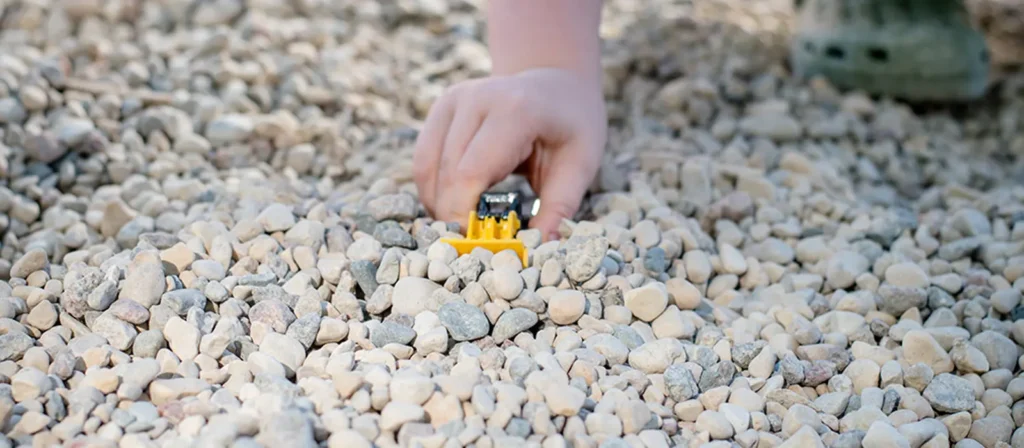
Pea gravel is a classic playground surface material that offers a natural and visually appealing play area. It comprises small rounded stones, provides excellent drainage, and is easy to maintain. Pea gravel is often combined with other materials to create a layered surface that offers cushioning and stability.
One of the advantages of pea gravel is its ability to drain water effectively. This prevents puddles from forming and allows children to continue playing even after rain. Pea gravel also offers good shock absorption, reducing the risk of injuries from falls.
Pea gravel can shift and become displaced over time, requiring occasional raking to maintain an even surface. It may also be more challenging for children with mobility aids or strollers to navigate. Despite these minor drawbacks, pea gravel remains a popular playground choice due to its natural aesthetics and excellent drainage properties.
5. Sand Playground Surface Material

Sand is a traditional playground surface material that provides children with a natural and sensory play experience. It provides excellent shock absorption and is relatively low maintenance. Sand is often combined with other materials to create a layered surface that provides cushioning and stability.
One of the benefits of sand is its ability to provide a soft landing surface that reduces the risk of falls and injuries with a natural and sensory play experience. Sand also provides endless opportunities for imaginative play, allowing children to build sand castles and dig to find buried treasure.
Sand can be messy and require regular raking to maintain an even surface. It can also become compacted over time, reducing its shock-absorbing properties. In addition, sand may not be suitable for children with certain allergies or asthma.
6. Poured Rubber Playground Surface Material
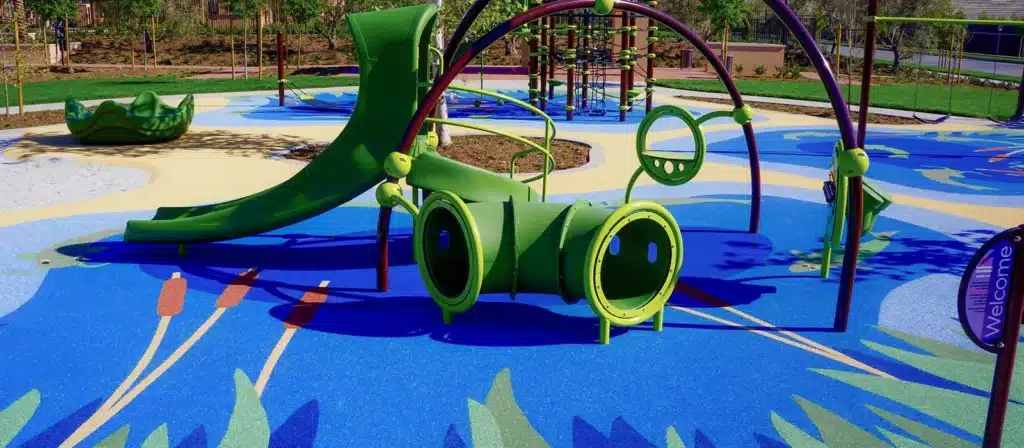
Poured rubber is a modern playground surface material with excellent shock absorption and durability. It is made from a combination of rubber granules and a binding agent, creating a seamless and cushioned surface. Poured rubber is available in various colors and designs, allowing for customization and creativity.
One of the advantages of poured rubber is its ability to provide a consistent and level surface. Its high CFH rating makes it suitable for play equipment of different heights. Additionally, poured rubber is non-toxic and resistant to weather conditions, making it a safe and long-lasting option.
Poured rubber can retain heat, making it hot on sunny days. It may also require occasional repairs to maintain its seamless surface. Poured rubber offers a visually appealing and safe playground surface material that requires minimal maintenance.
7. Wood Chips Playground Surface Material
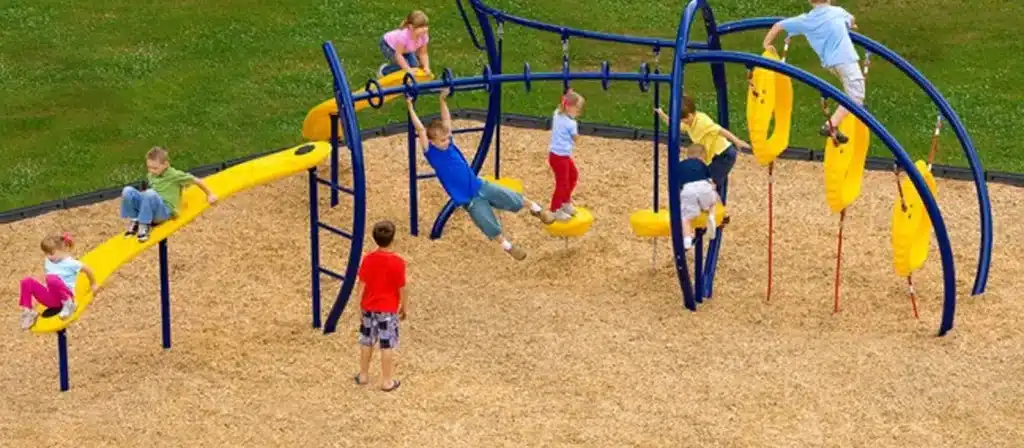
Wood chips are a natural and affordable playground surface material that absorbs shock. They offer a rustic and environmentally friendly play area from shredded or chipped wood. Wood chips are often combined with other materials to create a layered surface with cushioning and stability.
Wood chips are compelling enough to cushion falls and reduce the risk of injury. They also provide good drainage, preventing puddles from forming and allowing children to continue playing even after rain. Wood chips are readily available and can be replenished as needed.
Wood chips may require regular maintenance, including raking and replenishing, to maintain their desired depth and evenness. They may also attract insects or decompose over time, requiring periodic inspections.
Wood chips offer a natural, cost-effective playground surface material that promotes safety and a visually pleasing environment.
8. Natural Grass Playground Surface Material
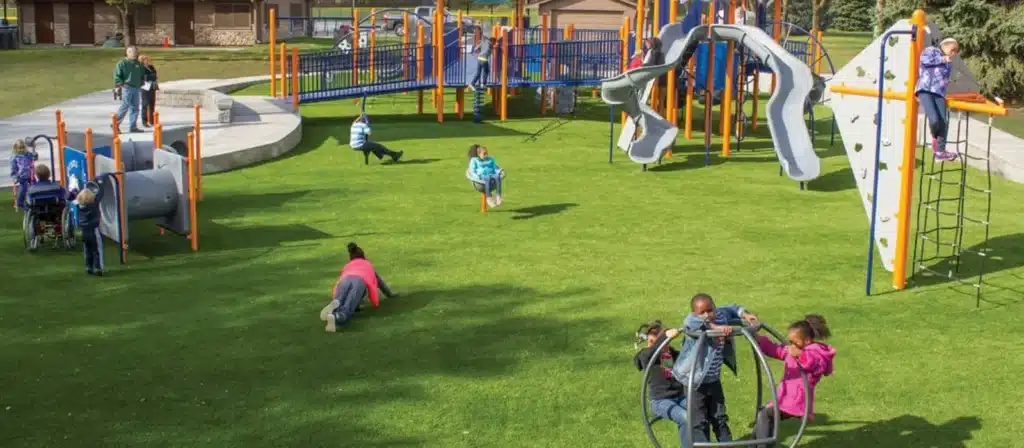
Natural grass is a traditional and environmentally friendly playground surface material that provides a soft and natural play area. It provides excellent shock absorption and is visually appealing. Natural grass is often combined with other materials to create a layered surface that provides cushioning and stability.
Natural grass provides a soft, comfortable landing surface that reduces the risk of fall injuries. It also provides a naturally inviting play environment that promotes a connection with nature.
Natural grass requires regular maintenance, including mowing, watering, and fertilizing to maintain its appearance and health. It may also become muddy and slippery after rain, requiring temporary closure for safety reasons.
Natural grass provides a beautiful and environmentally friendly playground surface material that promotes safety and a connection to nature.
Questions to Ask When Choosing Playground Surface Material
- Is the material compliant with safety standards such as ASTM or EN?
- Does it provide adequate impact absorption to minimize injuries from falls?
- Is the material non-toxic and free from harmful chemicals?
- How durable is the material under heavy use and varying weather conditions?
- What is the expected lifespan of the material?
- Does the material require regular maintenance or replacement?
- What are the long-term maintenance costs?
- Are there any additional costs for repairs or replacement over time?
- Is the surface slip-resistant to prevent accidents?
- Does it provide a suitable balance of firmness and cushioning?
- How complex is the installation process?
- Can it be installed over existing surfaces, or does the old surface need to be removed?
In conclusion
Choosing the right playground surface material is crucial for creating a safe and secure play environment for children. Each material has unique characteristics and benefits, so it’s essential to consider factors such as safety, maintenance, and aesthetics before deciding. Whether you opt for traditional options like sand and pea gravel or modern alternatives like rubber tiles and synthetic turf, selecting the right surface material will ensure that children can play freely and happily. So go ahead, explore the options, and create a playground that promotes fun and safety for all the little adventurers in your life.

